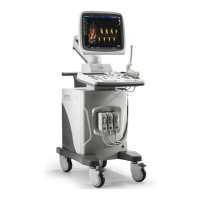SSI-6000/SSI-5800/SSI-5500/SSI-5500BW
Digital Color Doppler Ultrasound System
Thermal
Models
Composition Mode Specification Typ. app
1TIS Soft tissue Unscanned Large aperture
(>1cm
)
Liver PW
2TIS Soft tissue Unscanned Small aperture
(<1cm
)
Pencil probe
3TIS Soft tissue Scanned Evaluated at sur-
face
Breast color
4TIB Soft tissue and
bone
Scanned Soft tissue at sur-
face
Muscle color
5TIB Soft tissue and
bone
Unscanned Bone at focus Fetus head
PW
6TIC Soft tissue and
bone
Unscanned /
Scanned
Bone at surface Trans cranial
Soft tissue
Describes low fat content tissue that does not contain calcifications or large gas-
filled spaces.
Scanned: (auto-scan)
Refers to the steering of successive burst through the field of view, e.g. B and color
mode.
UnScanned
Emission of ultrasonic pulses occurs along a single line of sight and is unchanged
until the transducer is moved to a new position. For instance, the PW, CW and M
mode.
TI
TI is defined as the ratio of the In Situ acoustic power (W.3) to the acoustic power
required to raise tissue temperature by 1oC (Wdeg),
T I = W./W deg
Three TIs corresponding to soft tissue (TIS) for abdominal; bone (TIB) for fetal and
neonatal cephalic; and cranial bone (TIC) for pediatric and adult cephalic, have
been developed for applications in different exams.
An estimate of the acoustic power in milliwatts necessary to produce a 1°Ctemperature
elevation in soft tissue is:
W deg = / f c
for model 1 to 4, where fc is the center frequency in MHz.
W deg = · K · D
for model 5 and 6, where K (beam shape factor) is 1.0, D is the aperture diameter in
cm at the depth of interest
MI
Cavitation is more likely to occur at high pressures and low frequencies in pulse
ultrasound wave in the tissue, which contains the bubble or air pocket (for instance,
the lung, intestine, or scan with gas contrast agents). The threshold under optimum
conditions of pulsed ultrasound is predicted by the ratio of the peak pressure to the
square root of the frequency.
MI = Pr
0
/
p
f c
P/N: 4701-0061-01B
1-8

